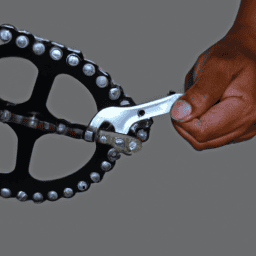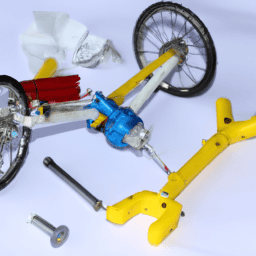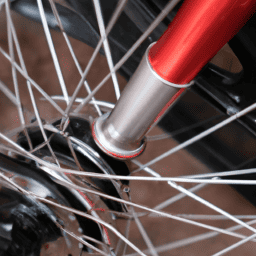If you’ve noticed that your bicycle chain is slack, leading to a less effective riding experience, there’s no need for concern. Tightening your chain is an easy upkeep activity that any rider can manage. In this piece, we’re going to guide you through the process of correctly tightening your bicycle chain to ensure it remains in optimal condition.
Before we get started, it’s important to understand the anatomy of a bicycle chain. A chain consists of a series of links, each with two pins that are connected by a roller. These links are held together by plates that form the outer surface of the chain. The length of the chain is determined by the number of links, and it’s important to have the correct tension in the chain to ensure smooth operation.
Now that you have a basic understanding of how your chain works, let’s gather the tools you’ll need to tighten it up.
Key Takeaways
- Proper chain tension involves finding a balance between loose and tight, and checking periodically
- Distance between chainstay and chain midpoint should be 1-2cm for proper tension, and rear axle nuts must be loosened to adjust tension
- Lubrication is important for reduced friction and well-oiled chain, but over-lubrication can cause dirt and dust to stick to chain
- Checking chain wear and length is crucial for determining correct tension, and worn-out chain can cause damage to other bike components.
Understand the Anatomy of a Bicycle Chain
You’ll want to take a closer look at the chain and its various components, so you can better understand how to tighten it and keep your ride smooth and efficient.
Start by checking the chain lubrication. A well-lubricated chain will not only extend its life but also reduce friction and make pedaling easier. You can use a bike-specific lubricant to keep the chain well-oiled. Make sure to wipe off any excess lubricant after applying it to prevent dirt and grime from sticking to the chain.
Another important thing to look for is chain wear indicators. These are small metal pegs that stick out from the sides of the chain links. If the chain wear indicators are flush with the chain, it means that the chain has stretched beyond its recommended limit and needs to be replaced.
Knowing when to replace the chain is essential as a worn-out chain can cause damage to other components of the bike.
Once you’ve checked these components, you’re ready to gather the necessary tools to tighten the chain.
Gather the Necessary Tools
No repair job is complete without the right gear, so make sure you’ve got all the tools you need before you get started. The tools required for tightening a bicycle chain are fairly straightforward.
You will need a chain tool, a wrench, and some lubricant. A chain tool is essential for removing links from the chain, while a wrench is required to loosen the bolts that hold the rear wheel in place. Proper lubrication is also important to ensure that your chain runs smoothly, so be sure to have some chain lubricant on hand.
One of the most common mistakes people make when tightening their bicycle chain is over-tightening it. This can cause undue stress on the chain and sprockets, leading to premature wear and tear. It’s important to find the right balance between a loose and tight chain.
In the next section, we will discuss how to determine the correct chain tension and ensure that your bicycle chain is properly tightened.
Determine the Correct Chain Tension
To ensure smooth and efficient biking, it’s crucial to find the sweet spot between a loose and overly tense chain. Determining the correct chain tension involves checking the chain length and wear.
First, measure the chain length by placing a ruler at the midpoint of the chain and counting the number of links within 12 inches. A new chain typically has 12 links in this measurement, so if your chain has stretched beyond this point, it may need to be replaced.
Next, inspect the chain wear by examining the teeth on the rear cassette and chainring. If the teeth are worn down, the chain may have stretched too much and need to be replaced. If the chain wear is minimal, you can move on to adjusting the chain tension.
It’s important to find the right balance between a slack chain that can slip off the gears and a tight chain that can cause excessive wear.
Adjust the Chain Tension
Feeling like a contortionist, you’re going to have to twist and manipulate the rear wheel to find the sweet spot of chain tension.
Begin by loosening the rear axle nuts just enough to allow some movement of the rear wheel. Then, using a ruler or an alignment tool, measure the distance between the center of the chainstay and the center of the chain at the midpoint of the chain run.
This measurement should be approximately 1-2cm for a properly tensioned chain. Once you’ve determined the chain tension needs adjustment, use a wrench to turn the rear axle nuts clockwise or counterclockwise, depending on which direction is needed to achieve the desired chain tension.
Then, tighten the axle nuts while holding the wheel in position to maintain the chain tension. Remember to check the chain tension periodically as chain stretching and chain lubrication can alter the tension over time.
With proper maintenance, your bicycle chain will last longer and provide a smoother ride.
Maintain Your Bicycle Chain
Keeping your bike chain in good condition will ensure a smoother and more enjoyable ride. One important aspect of maintaining your bicycle chain is chain lubrication. Over time, dirt and dust can accumulate on your chain, which can cause friction and wear down the components.
By applying lubrication to your chain, you can reduce friction and improve the lifespan of your bicycle chain. When it comes to chain lubrication, it’s important to choose the right type of lubricant. There are many different types of lubricants available, each with their own unique advantages and disadvantages.
Some lubricants are designed to be long-lasting, while others are designed to be lightweight and easy to apply. Additionally, it’s important to apply lubrication to your chain regularly, as over-lubrication can cause dirt and dust to stick to your chain, which can cause it to wear down more quickly.
By staying on top of your chain lubrication, you can avoid common chain issues and keep your bicycle running smoothly for years to come.
Frequently Asked Questions
How often should I tighten my bicycle chain?
To optimize your bike’s performance, it’s important to maintain proper chain tension by tightening it regularly. Benefits of regular chain maintenance include smoother shifting, increased power transfer, and longer chain life.
Can a loose chain cause damage to other parts of my bicycle?
Oh, definitely not. Letting your chain hang loose and free won’t cause any issues with your bike. Unless, of course, you’re interested in things like chain maintenance and avoiding expensive chain replacements.
What are the signs of a chain that needs tightening?
To determine if your bicycle chain needs tightening, check for chain wear indicators, which are markings on the chain that indicate stretching. Alternatively, use a chain checker tool to measure the chain’s length.
Is it necessary to clean my chain before tightening it?
A clean chain is essential for optimal chain maintenance. It prolongs the life of your bike and improves performance. Before tightening, it’s recommended to clean the chain to reap the benefits of a clean chain.
Can I use any type of lubricant on my bicycle chain?
To keep your bicycle chain running smoothly, use a lubricant specifically designed for bike chains. Good options include wet and dry lubes, as well as ceramic and wax-based lubes. Consider factors like weather conditions and riding style when choosing the best lubricant for your bike.
Conclusion
Congratulations! You’ve successfully tightened your bicycle chain. By understanding the anatomy of a bicycle chain and following the steps outlined in this article, you’ve ensured that your chain is functioning optimally.
Remember to maintain your bicycle chain regularly to prevent it from becoming loose again and to extend its lifespan.
In addition to tightening your bicycle chain, it’s important to regularly check your bike’s tire pressure, brake pads, and other components to ensure your safety and the longevity of your bike.
By taking care of your bike and performing regular maintenance, you can enjoy a smooth and safe ride every time. Keep up the good work, and happy cycling!









